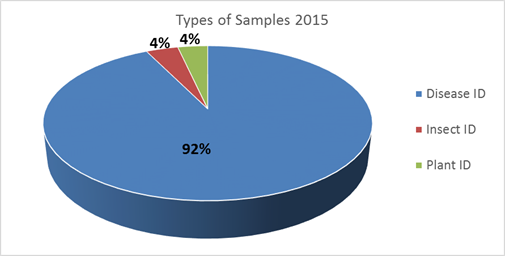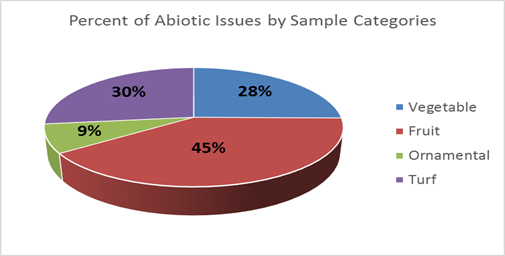Taking an environmentally sensitive approach to pest management
Plant Diagnostic Clinic: End of the Year Summary for Horticultural Plants
Published: December 14, 2015
As of December 11th, 2015, the Plant Diagnostic Clinic (PDC) had 403 samples submitted. Most of the the samples were submitted for disease diagnosis, though some were for insect or plant identification (Figure 1). Despite the excessive rain and cool summer temperatures, growers and homeowners still had plant health issues to deal with. The diversity of horticultural plants submitted to the clinic was vast. A complete list of diagnosed diseases, by host, can be found below (Tables 1-4). Abiotic issues, such as chemical injuries or environmental issues, were also diagnosed in all the sample categories (Figure 2).
Due to the a rain-filled spring and early summer, not surprisingly, diagnosis of Pythium and Phytophthora diseases were numerous in many hosts. Both pathogens are oomycetes, or water molds, meaning they love water and cause epidemics quickly in saturated situations. Both organisms take advantage of excess water by producing a motile spore called a zoospore, that uses flagella to swim from root to root or plant to plant. Bacterial diseases were also commonly diagnosed in a multitude of hosts, since rain splash moves these organisms from leaf to leaf. Numerous fungal diseases were also diagnosed on evergreen ornamentals. We saw a reduction of these with the warmer, drier weather of late July - September, but observed a resurgence in late October and November.
The PDC is open year round for sample submission. The typical turn around is 48 hours, depending on the day of the week the sample is submitted. If special testing is required, such as an ELISA or culture plating, turn around time varies. A general diagnosis is $15, additional services are $10 each. For horticultural crops, additional services may include culture plating, serological assays (ELISA or immunotrips) or other miscellaneous molecular testing methods.
Please see the PDC website (http://plantclinic.missouri.edu) or call (573-882-3019) for more information.
Figure 1:

Figure 2:

Table 1: Diagnosed Pest Issues on Vegetables
Host |
Diagnosis (Causal agent): Number of confirmed samples |
Bell Pepper |
Alternaria Leaf Spot (Alternaria spp.) : 1 |
Bell Pepper |
Bacterial Leaf Spot (Xanthomonas spp.) : 1 |
Broccoli |
Black Spot (Alternaria spp.) : 1 |
Cabbage |
Black Spot (Alternaria spp.) : 1 |
Cucumber |
Anthracnose (Colletotrichum orbiculare) : 1 |
Cucumber |
Bacterial Soft Rot (Unidentified Bacterium) : 1 |
Garlic |
Bacterial Soft Rot (Erwinia spp.) : 1 |
Kale |
Black Spot (Alternaria spp.) : 1 |
Napa; Chinese cabbage |
Black Spot (Alternaria spp.) : 1 |
Pumpkin |
Fusarium Crown Rot (Fusarium solani f.sp. cucurbitae) : 1 |
Rhubarb |
Slugs (Mollusca; Gastropoda) : 1 |
Tomato |
Alternaria Leaf Spot (Alternaria spp.) : 1 |
Tomato |
Bacterial Canker (Clavibacter michiganensis michiganensis) : 1 |
Tomato |
Brown root rot (Colletotrichum coccodes) : 1 |
Tomato |
Early Blight (Alternaria solani) : 5 |
Tomato |
Fusarium Crown Rot (Fusarium spp.) : 1 |
Tomato |
Gray Mold (Botrytis cinerea) : 1 |
Tomato |
Lesion Nematodes (Pratylenchus spp.) : 1 |
Tomato |
Onion Thrips (Thrips tabaci) : 1 |
Tomato |
Root-knot Nematodes (Meloidogyne spp.) : 2 |
Tomato |
Septoria Leaf Spot (Septoria spp.) : 2 |
Tomato |
Southern Blight (Sclerotium rolfsii) : 1 |
Zucchini Squash |
Cucurbit Bacterial Wilt (Erwinia tracheiphila) : 1 |
Table 2: Diagnosed Pest Issues on Fruits
Host |
Diagnosis: (Causal agent): Number of confirmed samples |
Apple |
Fire Blight (Erwinia amylovora) : 1 |
Blackberry |
Spur; Cane Blight (Didymella applanata) : 1 |
Blueberry |
Alternaria Leaf Spot (Alternaria spp.) : 1 |
Blueberry |
Crown and Root Rot (Phytophthora spp.) : 1 |
Blueberry |
Gloeosporium Leaf Spot (Gloeosporium spp.) :1 |
Cantaloupe |
Alternaria Leaf Blight (Alternaria spp.) : 1 |
Cantaloupe |
Alternaria Leaf Blight and Spot (Alternaria cucumerina) : 1 |
Cantaloupe |
Cucurbit Bacterial Wilt (Erwinia tracheiphila) : 1 |
Grape |
Bitter Rot (Greeneria uvicola) : 1 |
Grape |
Crown Gall (Agrobacterium vitis) : 1 |
Grape |
Grape Downy Mildew (Plasmopara viticola) : 2 |
Grape |
Grape Phylloxera (Daktulosphaira vitifoliae) : 1 |
Grape |
Pierce's Disease (Xylella fastidiosa) : 1 |
Grape |
Leaf Spot (Pestalotia spp.) : 2 |
Grape |
Phomopsis Rachis Rot (Phomopsis spp.) : 1 |
Peach |
San Jose Scale (Diaspidiotus perniciosus) : 1 |
Peach |
Scab (Cladosporium spp.) : 1 |
Pear |
Fire Blight (Erwinia amylovora) : 1 |
Pear |
Pear Stony Pit (Pear Stony Pit Virus) : 1 |
Strawberry |
Cylindrocarpon Crown Rot (Neonectria spp.) : 1 |
Strawberry |
Powdery Mildew (Podosphaera macularis) : 1 |
Strawberry |
Twospotted Spider Mite (Tetranychus urticae) : 2 |
Watermelon |
Alternaria Leaf Blight or spot (Alternaria spp.) : 4 |
Watermelon |
Anthracnose (Colletotrichum orbiculare) : 1 |
Watermelon |
Aphids (Aphis spp.) : 1 |
Watermelon |
Bacterial Fruit Blotch (Acidovorax avenae citrulli) : 1 |
Watermelon |
Cercospora Leaf Spot (Cercospora spp.) : 2 |
Watermelon |
Cucurbit Gummy Stem Blight (Didymella bryoniae) : 1 |
Watermelon |
Fusarium Fruit Rot (Fusarium spp.) : 1 |
Watermelon |
Phytophthora Fruit Rot (Phytophthora spp.) : 2 |
Table 3: Diagnosed Pest Issues on Ornamental plants.
Host |
Diagnosis: (Causal agent): Number of confirmed samples |
Arborvitae |
Kabatina Twig Blight (Kabatina thujae) : 1 |
Ash |
Ash Decline Complex (Unidentified Agent) : 1 |
Ash |
Ash Flower Gall Mite (Eriophyes fraxiniflora) : 2 |
Ash |
Mycosphaerella Leaf Spot (Mycosphaerella spp.) : 1 |
Boxwood |
Armored Scales (Family Diaspididae) : 1 |
Boxwood |
Macrophoma Leaf Spot (Macrophoma candollei) : 1 |
Boxwood |
Volutella Leaf Blight (Volutella spp. ) : 1 |
Burning Bush |
Mealybug (Family Pseudococcidae.) : 1 |
Eastern Red cedar |
Needle Blight (Cercospora spp.) : 1 |
Chinese Chestnut |
Wood Decay Fungus (Unidentified Fungus) : 1 |
Chrysanthemum |
Alternaria Leaf Blight (Alternaria spp.) : 1 |
Chrysanthemum |
Pythium Root and Crown Rot (Pythium spp.) : 1 |
Flowering Dogwood |
Dogwood Anthracnose (Discula destructiva) : 1 |
American Elm |
Dutch Elm Disease (Ophiostoma spp.) : 1 |
Elm |
alcohol flux : 1 |
Douglas-fir |
Diplodia Tip Blight (Diplodia pinea) : 1 |
Douglas-fir |
Phomopsis Tip Blight (Phomopsis juniperovora) : 1 |
Geranium |
Gray Mold (Botrytis cinerea) : 1 |
Holly |
Alternaria Leaf Spot (Alternaria spp.) : 1 |
Holly |
Armored Scales (Family Diaspididae) : 2 |
Holly |
Canker and Dieback (Botryosphaeria dothidea) 2 |
English Ivy |
Anthracnose (Colletotrichum spp.) : 1 |
Juniper |
Seiridium Canker (Seiridium spp.) : 3 |
Juniper |
Eastern Juniper Bark Beetle (Phloeosinus dentatus) : 1 |
Juniper |
Juniper Scale (Carulaspis juniperi) : 1 |
Juniper |
Phomopsis Tip Blight (Phomopsis juniperovora) : 1 |
Leyland Cypress |
Seiridium Canker (Seiridium spp.) : 1 |
Japanese Maple |
Dieback; Canker; Twig Blight (Botryosphaeria spp.) : 1 |
Japanese Maple |
Bark Beetles (Family Scolytidae) : 1 |
Maple |
Anthracnose (Colletotrichum spp.) : 2 |
Maple |
Armillaria Root Rot (Armillaria spp.) : 1 |
Maple |
Armored Scales (Family Diaspididae) : 1 |
Maple |
Spider Mites (Family Tetranychidae) : 1 |
Maple |
Termites (Order isoptera) : 1 |
Million Bells |
Pythium Root and Crown Rot (Pythium spp.) : 1 |
Oak |
Armored Scales (Family Diaspididae) : 1 |
Oak |
Bacterial Leaf Scorch (Xylella fastidiosa) : 6 |
Oak |
Bark Beetles (Family Scolytidae) : 3 |
Oak |
Canker (Hypoxylon spp.) : 1 |
Oak |
Dieback; Canker; Twig Blight (Botryosphaeria spp.) : 1 |
Oak |
Horned Oak Gall Wasp (Callirhytis cornigera) : 2 |
Oak |
Foliar Insect Gall (Insect Gall) : 2 |
Oak |
Tubakia Leaf Spot (Tubakia dryina) : 2 |
Oak |
Powdery Mildew (Erysiphe alphitoides) : 1 |
Oak |
Oak Wilt (Ceratocystis fagacearum) : 3 |
Oak |
Spider Mites (Family Tetranychidae) : 2 |
Phlox |
Anthracnose (Colletotrichum spp.) : 1 |
Pine |
Brown Spot Needle Blight (Mycosphaerella dearnessii) : 2 |
Pine |
Pine Needle Scale (Chionaspis pinifoliae) : 1 |
Pine |
Bark Beetles (Family Scolytidae) : 1 |
Privet |
Armillaria Root Rot (Armillaria spp.) : 1 |
Rose |
Alternaria Leaf Spot (Alternaria spp.) : 1 |
Rose |
Anthracnose (Colletotrichum spp.) : 1 |
Rose |
Powdery Mildew (Unidentified Fungus) : 1 |
Norway Spruce |
Spruce Spider Mite (Oligonychus ununguis) : 1 |
Norway Spruce |
Sudden Needle Drop (Setomelanomma holmii) : 2 |
Spruce |
Pine Needle Scale (Chionaspis pinifoliae) : 1 |
Spruce |
Rhizosphaera Needle Cast (Rhizosphaera kalkhoffii) : 2 |
Spruce |
Cytospora Canker; Dieback (Cytospora spp.) : 1 |
Spruce |
Phomopsis Tip Blight (Phomopsis juniperovora) : 1 |
Spruce |
Soft Scales (Family Coccidae) : 1 |
Dwarf Alberta spruce |
Adelgid (Adelges spp.) : 1 |
Supertunia |
Alternaria Leaf Blight (Alternaria spp.) : 1 |
Sweetgum |
Bacterial Leaf Scorch (Xylella fastidiosa) : 1 |
Viburnum |
Bacterial Blight (Pseudomonas syringae syringae) : 1 |
Weeping Cherry |
Dieback; Canker; Twig Blight (Botryosphaeria spp.) : 1 |
Weeping Cherry |
Fire Blight (Erwinia amylovora) : 1 |
Witch Hazel |
Phyllosticta Leaf Spot (Phyllosticta hamamelidis) : 1 |
Yew |
Mealybugs (Family Pseudococcidae) : 1 |
Table 4: Diagnosed Pest Issues on Turfgrass.
Host |
Diagnosis: (Causal agent): Number of confirmed samples |
Bluegrass |
Brown Patch (Rhizoctonia solani.) : 1 |
Bluegrass |
Summer Patch (Magnaporthiopsis poae) : 2 |
Bluegrass |
Grub damage (Various scarab beetle larva): 2 |
Tall Fescue |
Seedling Damping Off (Pythium spp.) : 1 |
Tall Fescue |
Brown Patch (Rhizoctonia solani.) : 1 |
Mixed turfgrass |
Slime Mold (Class Myxogastria) : 1 |
Mixed turfgrass |
Gray Leaf Spot (Pyricularia grisea) : 1 |
Subscribe to receive similar articles sent directly to your inbox!
- Free Oak Disease Testing Continues in 2025 (08/15/25)
- Melons: An August Treat (08/06/24)
- Winter Care of Hardy Mums (11/09/23)
REVISED: December 14, 2015